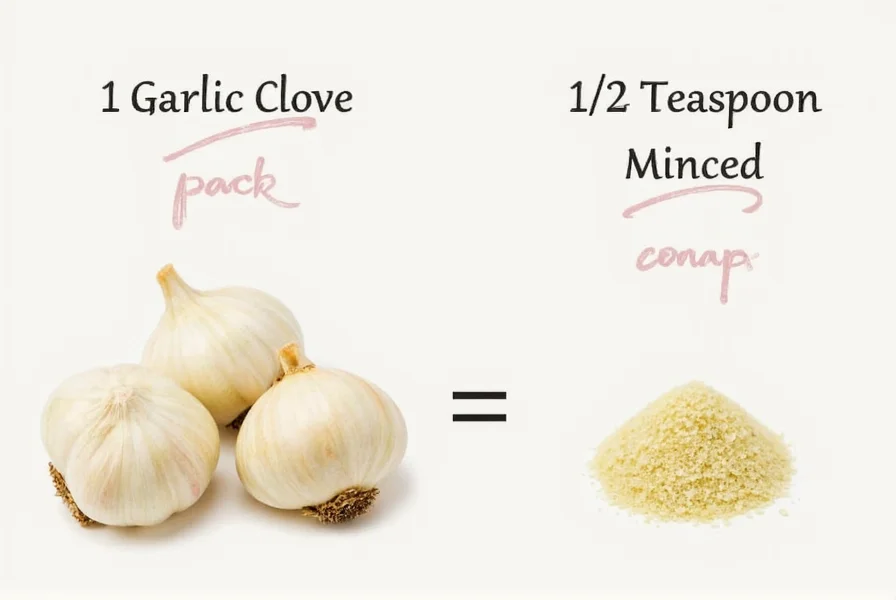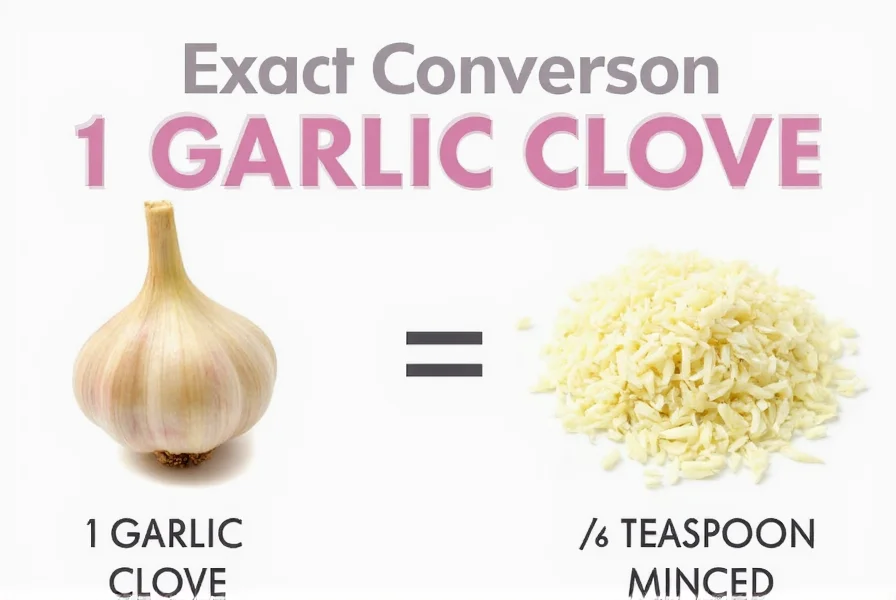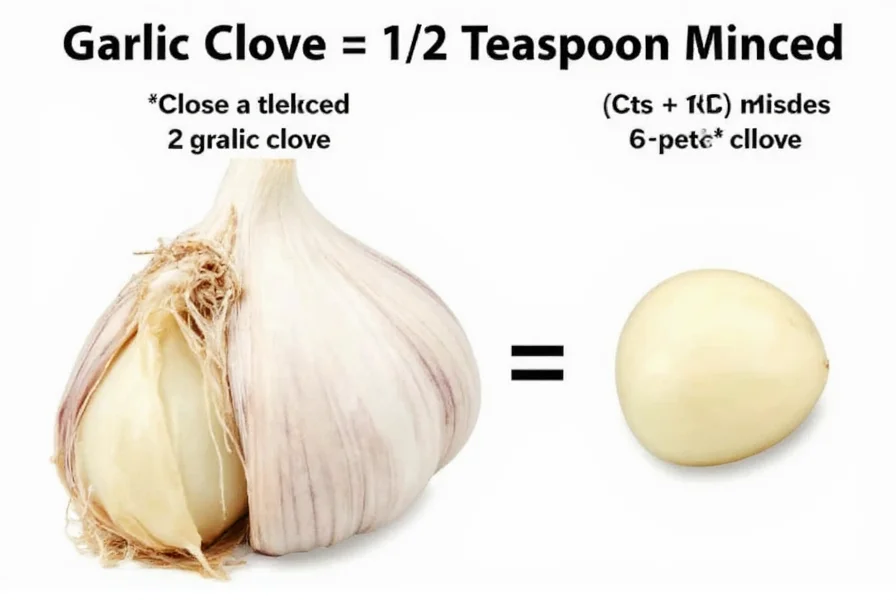One medium garlic clove equals approximately 1/2 teaspoon of minced garlic. For large cloves, the equivalent is about 1 teaspoon minced. These measurements apply to freshly minced garlic, not jarred or pre-minced varieties which may have different density and potency.
Understanding garlic measurements is essential for precise cooking and recipe adaptation. Whether you're following a family recipe that calls for cloves or a modern cookbook specifying teaspoons, knowing these conversions ensures your dishes achieve the perfect flavor balance without overpowering or under-seasoning.
Garlic Measurement Fundamentals
Garlic measurements vary based on clove size and preparation method. Unlike standardized measuring spoons, garlic cloves naturally differ in size depending on variety, growing conditions, and bulb position. This variation explains why precise conversion matters in recipe execution.
When recipes specify "garlic cloves," they typically assume medium-sized cloves (about 1 inch long and 3/4 inch in diameter). However, grocery store garlic can range dramatically in size, creating potential inconsistencies in your cooking results.
How Garlic Size Affects Measurement
The relationship between garlic cloves and teaspoon measurements depends primarily on three factors:
- Clove size - Small, medium, and large cloves yield significantly different volumes
- Preparation method - Minced, chopped, or crushed garlic occupies different space
- Packing density - How tightly the garlic is packed into the measuring spoon
| Garlic Form | Small Clove | Medium Clove | Large Clove |
|---|---|---|---|
| Minced | 1/4 tsp | 1/2 tsp | 1 tsp |
| Chopped | 1/3 tsp | 2/3 tsp | 1 1/4 tsp |
| Crushed | 1/3 tsp | 2/3 tsp | 1 1/4 tsp |
| Garlic Powder | 1/8 tsp | 1/4 tsp | 1/2 tsp |
| Garlic Salt | 1/4 tsp | 1/2 tsp | 1 tsp |
This comprehensive garlic conversion table shows measurements for various preparation methods. Note that chopped and crushed garlic yield similar volumes because both methods create comparable particle sizes, while minced garlic packs more densely.

Practical Measurement Techniques
When converting garlic cloves to teaspoons in your kitchen, consider these professional techniques:
For the most accurate measurement of minced garlic, use the "scoop and level" method similar to measuring flour. Gently fill your teaspoon without packing, then level off excess with a straight edge. Avoid pressing down on the garlic, which would increase density and alter the measurement.
When working with whole cloves, estimate size by comparing to common objects:
- Small clove - About the size of a pine nut
- Medium clove - Comparable to an almond
- Large clove - Similar to a walnut piece
These visual references provide quick size estimation when you don't have measuring spoons available while cooking.
Recipe Adaptation Strategies
Understanding garlic clove to teaspoon conversion becomes particularly valuable when adapting recipes. Many traditional recipes specify "garlic cloves" while modern recipes often use standardized measurements. When converting between these formats, consider both volume and potency factors.
Fresh garlic's potency varies based on freshness, variety, and growing conditions. Older garlic tends to be milder, while freshly harvested garlic delivers more intense flavor. This means that even with precise volume measurements, you may need to adjust to taste.

Special Considerations for Garlic Substitutions
When substituting between fresh garlic and processed alternatives, remember these important distinctions:
- Pre-minced garlic in jars often contains preservatives that slightly alter flavor and may have different density
- Garlic powder is significantly more concentrated - use 1/8 teaspoon powder per medium clove
- Roasted garlic has milder flavor - you may need 1.5 times the volume of raw garlic
- Garlic paste from tubes typically equals 1/2 teaspoon per medium clove
For international recipes, note that European recipes sometimes specify "garlic cloves" differently than American recipes. European garlic varieties often produce larger cloves, so a "medium" clove in France might equal a "large" clove in the United States.
When Precision Matters Most
Certain culinary applications demand precise garlic measurements:
- Delicate sauces like aioli or hollandaise where garlic can dominate other flavors
- Canning and preserving where proper acid balance affects food safety
- Baking savory items like garlic bread or focaccia where chemical reactions matter
- Professional recipe development requiring consistent results across batches
For everyday cooking, experienced chefs often rely on taste adjustments during preparation rather than strict measurements. However, when learning new recipes or cooking for others with specific preferences, precise measurements provide valuable consistency.
FAQ: Garlic Measurement Questions Answered
How many teaspoons of minced garlic equals one large garlic clove?
One large garlic clove equals approximately 1 teaspoon of freshly minced garlic. Large cloves typically measure about 1.25 inches long and 1 inch in diameter. When precision matters in recipes, this conversion ensures proper flavor balance without overwhelming other ingredients.
What's the difference between minced and chopped garlic measurements?
Minced garlic packs more densely than chopped, yielding slightly different measurements. One medium clove equals 1/2 teaspoon minced but 2/3 teaspoon chopped. The finer mince creates smaller particles that settle more tightly in the measuring spoon, while chopped garlic maintains more air space between larger pieces.
Can I substitute garlic powder for fresh garlic cloves?
Yes, but use 1/8 teaspoon garlic powder per medium garlic clove. Garlic powder is significantly more concentrated than fresh garlic, so direct 1:1 substitution would create overpowering flavor. Additionally, garlic powder lacks the moisture content of fresh garlic, which may affect recipe texture in baking applications.
Does roasting garlic change the teaspoon equivalent?
Roasted garlic has milder flavor than raw, so you'll need approximately 1.5 times the volume to achieve similar flavor intensity. One medium roasted clove equals about 3/4 teaspoon, compared to 1/2 teaspoon for raw. The roasting process breaks down compounds, creating sweeter, less pungent garlic that requires slightly more volume for equivalent flavor impact.
How do I measure garlic cloves without a knife or cutting board?
Use a garlic press for direct measurement into your spoon. Alternatively, crush the clove with the flat side of a chef's knife, then scrape the softened garlic directly into your measuring spoon. For approximate measurement without tools, remember that a medium clove equals one standard restaurant portion packet of garlic, typically 1/2 teaspoon.











 浙公网安备
33010002000092号
浙公网安备
33010002000092号 浙B2-20120091-4
浙B2-20120091-4